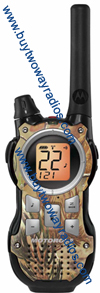 MR355R
MR355RHere at Buy Two Ways Radios we are excited to have some news on the new 2009 Motorola Talkabouts. There are some interesting new models and features this year, starting with the MR350 and MR355R.
Top of the Line
The Motorola MR350 and MR355R have some interesting features that have been added. The most obvious changes made to previous top of the line models include larger buttons to make operation easier while wearing gloves and a built in LED flashlight. There is also a new emergency alert feature. Pressing the alert button sends out an alert signal and a spoken message to other radios. The "claimed" range for both radios is 35 miles. The MR350 is black with sliver highlights and an MSRP of $79.99 (per pair) The MR355R has a Realtree® AP HD® Camo pattern faceplate, 8 repeater channels (When used with a repeater, this will greatly extend the range of the MR355R. Great for hunters, or anyone needing a large transmission area.), and an MSRP of $89.99 (per pair). Now in stock for $79.99!
Some Great Features
The Motorola MJ270R, while not having all of the options of the top of the line models, still has some great features. With a "claimed" range of 27 miles, 22 channels and 121 privacy codes, NOAA weather channels, LED flashlight, and the emergency alert, the MJ270 is a great radio for the outdoor enthusiast. The rugged case is back with a silver faceplate and an MSRP of $69.99 (per pair). Now in stock for $59.99!
Still Yellow!
Slightly less costly, but still loaded with features and looks, the MH230R is a good option. With a "claimed" range of 23 miles, 22 channels and 121 privacy codes, and NOAA weather channels. The MJ230R is a very good multi-use radio for everything from a camping trip to a trip to the mall. And yes, it has a disctintive yellow faceplate. The MJ230R has an MSRP of $59.99 (per pair). Now in stock for $49.99!
Easy to Charge
One of the things we like about these radios is the ability to charge off of a mini-USB cable and not just a desktop charger. Being able to charge from a desktop charger, in a car using a mini-USB cable, or even off of a notebook computer with a mini-USB computer cable is a great convenience.
Here is a complete list of all of Motorola's 2009 models:
MR350R - NOW IN STOCK! ($69.99) 22 Channels, 121 Privacy Codes, 11 Weather Channels (7 NOAA) with Alert Feature , LED Flashlight, iVOX, VibraCall Alert, QT (Quiet Talk) interruption Filter, Backlight Display, Battery Meter/Save Feature, Keypad Lock, 10 Call Tones, Priority Scan, PTT Power Boost, Mini USB Charging Port, Drop-in Charger, Charging Adapter.
T9680R - (MSRP $79.99) 22 Channels, 121 Privacy Codes, 11 Weather Channels (7 NOAA) with Alert Feature and SAME, LED Flashlight, iVOX, VibraCall Alert, QT (Quiet Talk) interruption Filter, Backlight Display, Battery Meter, Keypad Lock, 10 Call Tones, Priority Scan, PTT Power Boost, Mini USB Charging Port, Drop-in Charger, Charging Adapter.
MJ270R - NOW IN STOCK! ($59.99) 22 Channels, 121 Privacy Codes, 11 Weather Channels (7 NOAA), Emergency Alert Button, LED Flashlight, iVOX, QT (Quiet Talk) interruption Filter, Backlight Display, Battery Meter, Keypad Lock, 10 Call Tones, Priority Scan, Mini USB Charging Port, Drop-in Charger, Charging Adapter.
EM100R - (MSRP $69.99) 22 Channels, 121 Privacy Codes, 11 Weather Channels (7 NOAA), Emergency Alert Button, LED Flashlight, iVOX, QT (Quiet Talk) interruption Filter, Backlight Display, Battery Meter, Keypad Lock, 10 Call Tones, Priority Scan, Mini USB Charging Port, Drop-in Charger, Charging Adapter.
MH230R -NOW IN STOCK! ($49.99) 22 Channels, 121 Privacy Codes, iVOX, QT (Quiet Talk) Interruption Filter, Backlight Display, Battery Meter, Keypad Lock, 10 Call Tones, Priority Scan, Mini USB Charging Port, Drop-in Charger, Charging Adapter. YELLOW!
SX600R - (MSRP $39.99) 22 Channels, 121 Privacy Codes, iVOX, QT (Quiet Talk) Interruption Filter, Backlight Display, Battery Meter, Keypad Lock, 10 Call Tones, Priority Scan, Mini USB Charging Port, Drop-in Charger, Charging Adapter.
FV300R - (MSRP $29.99) 22 Channels, Priority Scan, Keypad Lock, Battery Meter, 10 Call Tones, Plug In Charger
FV300 - (MSRP $19.99) 22 Channels, Priority Scan, Keypad Lock, Battery Meter, 10 Call Tones.
The following feature the Realtree® AP HD® Camo pattern:
MR355R -- NOW IN STOCK! ($79.99) 22 Channels, 121 Privacy Codes, 8 Repeater Channels, 11 Weather Channels with Alert, Emergency Alert Button, LED Flashlight, iVOX, VibraCall Alert, QT (Quiet Talk) interruption Filter, Backlight Display, Battery Meter, Replaceable Faceplate, Keypad Lock, 10 Call Tones, Priority Scan, PTT Power Boost, Mini USB Charging Prot, Drop-in Charger, Digital Signal Processing , Charging Adapter, 2 PPT Earbuds.
T9650XLR - (MSRP $119.9) 22 Channels, 121 Privacy Codes, 11 Weather Channels with Alert, iVOX, VibraCall Alert, QT (Quiet Talk) interruption Filter, Backlight Display, Battery Meter, Replaceable Faceplate, Keypad Lock, 10 Call Tones (5 Animal), Priority Scan, PTT Power Boost, Drop-in Charger, Digital Signal Processing , Charging Adapter, 2 Earpiece with Boom Microphone, 1 Car Charger.
T9550XLR - (MSRP $79.99) 22 Channels, 121 Privacy Codes, 11 Weather Channels with Alert, iVOX, VibraCall Alert, QT (Quiet Talk) interruption Filter, Backlight Display, Battery Meter, Replaceable Faceplate, Keypad Lock, 10 Call Tones, Priority Scan, PTT Power Boost, Drop-in Charger, Digital Signal Processing , Charging Adapter, 2 PPT Earbuds.
8550XLR - (MSRP $69.99) 22 Channels, 121 Privacy Codes, 11 Weather Channels with Alert, iVOX, VibraCall Alert, QT (Quiet Talk) interruption Filter, Backlight Display, Battery Meter, Keypad Lock, 10 Call Tones, Priority Scan, Digital Signal Processing, Drop-in Charger, Charging Adapter, 2 PPT Earbuds.





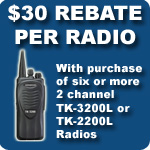

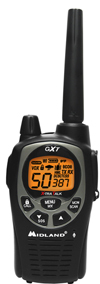
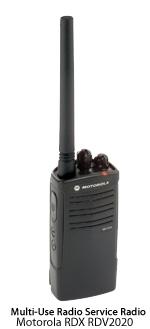 Do you need a high powered two way radio, but don't want to deal with the hassle of licensing?
Do you need a high powered two way radio, but don't want to deal with the hassle of licensing? 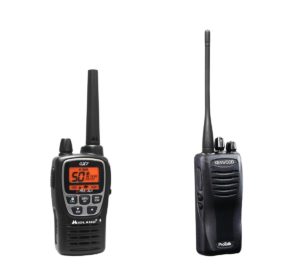


 Customers who are new to business radios are confronted with several confusing options, one of which is the type of frequency band to choose. This particular option consists of two choices, either UHF or VHF. These abbreviations make no sense to most people and without some research it is easy to choose a radio that is not right for your situation. So how do you determine which is the best choice for your application?
Customers who are new to business radios are confronted with several confusing options, one of which is the type of frequency band to choose. This particular option consists of two choices, either UHF or VHF. These abbreviations make no sense to most people and without some research it is easy to choose a radio that is not right for your situation. So how do you determine which is the best choice for your application?
